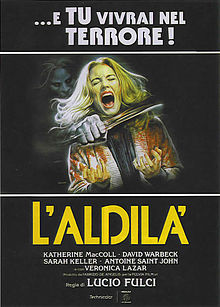 The undoubted masterpiece of Lucio Fulci, a crazed and surreal gorefest that’s irresistible, even if it doesn’t make much sense.
The undoubted masterpiece of Lucio Fulci, a crazed and surreal gorefest that’s irresistible, even if it doesn’t make much sense.
1981’s THE BEYOND (original title: E TU VIVRAI NEL TERRORE—L’ALDILA, or AND YOU WILL LIVE IN TERROR: THE BEYOND) is a companion-piece to Lucio Fulci’s previous film CITY OF THE LIVING DEAD (1980), an atmospheric zombie-fest with oodles of gore and a largely incoherent narrative. THE BEYOND is quite similar, but even gorier and less coherent.
Back in the eighties the film was released in heavily cut and rescored form on VHS in the U.S. (as SEVEN DOORS OF DEATH). For years the uncut BEYOND was a sought-after legend among horror mavens, and one of the key titles of the greymarket underground of the 1990s (with VHS dubs of the Japanese laserdisc version of the film proliferating). In 1998 THE BEYOND was given its first-ever U.S. theatrical run by Sage Stallone’s Grindhouse Releasing and Quentin Tarantino’s Rolling Thunder Pictures, and was a hit, briefly reviving the then-moribund midnight movie circuit–and in 2000 was finally released on DVD.
You may think there’s little point in transcribing the narrative of a film as scatterbrained as this one, and, frankly, you’d be right. But anyway…
A young blonde named Liza has inherited a New Orleans hotel where, unbeknownst to her, a surrealist painter was whipped and crucified decades earlier. Before dying the painter informed his tormentors that the property was constructed over one of the seven gateways to Hell.
Upon moving into the place Liza discovers that the basement has been flooded. She calls in a plumber who breaks through a wall in the basement, behind which the corpse of the aforementioned painter is interred–before the plumber can report his finding, however, his eyeballs are gouged out by a zombie. Liza for her part nearly runs down a blind, moon-eyed woman who for some reason is standing in the middle of a bridge with her dog. Said woman lives in an old house near Liza’s hotel, and warns that the gates of Hell are about to be opened.
Liza investigates her hotel and discovers an old book entitled “Eibon”—and experiences a vision of the crucified painter. When she turns back she finds the Eibon book has mysteriously disappeared. It turns up the following day in a nearby bookshop, whose owner says it’s been there “for the past two years.” Meanwhile, a man is searching an antiquarian bookshop for a map of Liza’s hotel, which he finds in a book accessible only by a tall ladder; from it he falls and cracks his head on the floor, where several tarantulas literally crawl out of the woodwork and devour him.
Back in the hotel a woman caretaker is attacked by the zombified plumber, who pushes her head onto a stake that pops out the woman’s eye. The aforementioned blind gal fares even worse, getting harassed by a gaggle of zombies and then having her throat ripped out by her beloved dog—not that this matters much, because Liza is later informed that the woman’s house has actually been deserted for years.
It seems Hell’s gates have definitely been opened, as zombies overrun Liza’s hotel. She and her boyfriend head off to the local hospital, where more zombies await. The only way out is a dash (literally) into one of the paintings by the artist who lived in the hotel originally and started the whole mess…
Anyone curious about what made Lucio Fulci a singular filmmaker needs to see THE BEYOND. Its combination of eerie atmospherics and sheer outrageousness is quite unique, with beautifully lit and composed widescreen visuals juxtaposed with, among innumerable other outrages, a close-up of a spider’s tendril reaching into a man’s mouth and yanking out his tongue. Other striking elements include a woman getting her throat ripped out by a dog, with Fulci’s camera characteristically lingering on the gushing blood, as well as the rather poetic sight of a (never explained) bleeding wall and the richly atmospheric scenery of eighties-era New Orleans, where much of the film was lensed.
There’s enough gore and slime here to fill several more conventional splatter films, all of it impressively rendered by special effects ace Gianetto de Rossi, yet the artfulness of the enterprise is undeniable. Credit must go to cinematographer Sergio Salvati and editor Vincenzo Tomassi, as well as Fulci himself, a far better filmmaker than most people (including many of his so-called fans) give him credit for. The film is also colorful and fast-moving, and at 89 minutes never overstays its welcome.
Narratively, the templates for THE BEYOND appear to have been Dario Argento’s SUSPIRIA and INFERNO, with their successions of tenuously connected horrific set-pieces. The present film is even more disconnected and incoherent than Argento’s, although it must be said that THE BEYOND’S wonky non-narrative is one of its primary charms: the film is genuinely dreamlike and surreal, more so in some respects than the work of arty auteurs like Lynch, Greenaway, etc. Not too many films can get away with a final scene in which the protagonists literally find themselves trapped in a surreal painting, but in THE BEYOND such a development seems entirely appropriate.
Vital Statistics
THE BEYOND (E TU VIVRAI NEL TERRORE–L’ALDILA)
Fulva Film/Rolling Thunder Pictures/Grindhouse Releasing
Director: Lucio Fulci
Producer: Fabrizio de Angelis
Screenplay: Dardano Sacchetti, Giorgio Mariuzzo, Lucio Fulci
Cinematography: Sergio Salvati
Editing: Vincenzo Tomassi
Cast: Catriona MacColl, David Warbeck, Sarah Keller, Antoine Saint John, Veronica Lazar, Anthony Flees, Giovanni de Nava, Al Cliver, Michele Mirabella, Gianpaolo Saccarola
